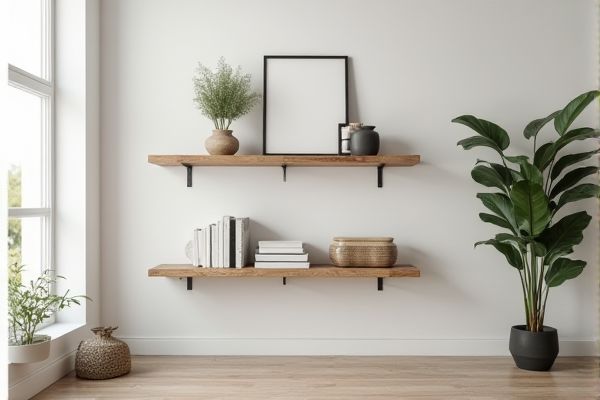
Floating shelves create a minimalist look by attaching directly to the wall without visible brackets, while wall shelves often have supporting brackets that add to their aesthetic and structural design. Discover which shelf type best suits your space and style needs by exploring the rest of this article.
Table of Comparison
| Feature | Floating Shelf | Wall Shelf |
|---|---|---|
| Installation | Mounted with hidden brackets for a seamless look | Mounted with visible brackets or supports |
| Design | Minimalistic and modern appearance | Traditional to contemporary styles with visible hardware |
| Weight Capacity | Supports moderate weight depending on bracket strength | Often supports heavier loads due to visible support system |
| Maintenance | Easy to clean due to lack of visible hardware | May collect dust around brackets, requiring frequent cleaning |
| Cost | Typically higher due to specialized mounting hardware | Generally more affordable with standard brackets |
| Best Use | Display items in modern interiors and minimalist spaces | Storage and display with focus on strength and style variety |
Introduction to Floating Shelves vs Wall Shelves
Floating shelves provide a sleek, modern look with concealed brackets, creating the illusion of a shelf that "floats" on the wall, making them ideal for minimalist and contemporary interiors. Wall shelves, typically supported by visible brackets or frames, offer robust support and classic versatility suitable for heavier items and traditional decor styles. Choosing between floating shelves and wall shelves depends on your aesthetic preferences, storage needs, and the weight capacity required for your space.
Design and Aesthetic Appeal
Floating shelves offer a sleek, minimalist design with concealed brackets, creating a clean, modern look that seamlessly blends with various interior styles. Wall shelves tend to have visible supports or brackets, which can add a traditional or industrial touch depending on the material and design. The choice between floating and wall shelves significantly influences the room's aesthetic, with floating shelves enhancing open, streamlined spaces and wall shelves providing structural or decorative accents.
Installation Process and Complexity
Floating shelves require mounting hidden brackets directly into wall studs, demanding precise measurements and use of a level for a seamless, bracket-free appearance. Wall shelves often come with visible brackets or supports, making installation simpler and more forgiving, typically requiring only basic tools like a drill and screws. Your choice depends on your comfort level with DIY tasks and the aesthetic you want, as floating shelves offer a sleek look but involve a more complex installation process.
Weight Capacity and Durability
Floating shelves typically support moderate weight, ranging from 15 to 50 pounds, depending on anchor types and wall material, while wall shelves often have higher weight capacities due to robust bracket support. Durability of floating shelves depends on solid wood or high-quality MDF construction and secure mounting, ensuring long-term stability; wall shelves, with metal or wooden brackets, offer enhanced resilience for heavier items. Choosing the right shelf for your space depends on your weight requirements and desired durability against daily use.
Space Optimization and Functionality
Floating shelves maximize space optimization by eliminating bulky brackets, creating a sleek, unobstructed surface ideal for small rooms or minimalist designs. Wall shelves offer greater load-bearing capacity, making them functional for heavier items and providing customizable storage configurations through adjustable brackets. Your choice depends on balancing aesthetic appeal with the need for durability and storage versatility in your space.
Cost Comparison and Budget Considerations
Floating shelves typically cost more due to hidden brackets and sleek design, with prices ranging from $30 to $150 depending on materials and size. Wall shelves, often supported by visible brackets, tend to be more budget-friendly, starting as low as $15 and offering a wider variety of lower-cost options. When considering budget, factor installation complexity and desired aesthetic, as floating shelves may require professional mounting, increasing overall expenses.
Versatility in Home Decor
Floating shelves offer sleek, minimalist designs that blend seamlessly into modern interiors, making them ideal for showcasing decor without visual bulk. Wall shelves come in various styles and materials, providing more traditional or rustic looks that complement diverse home aesthetics. Your choice between the two depends on the versatility needed to match and enhance your existing decor elements while maximizing functional space.
Maintenance and Cleaning
Floating shelves require minimal maintenance due to their concealed brackets, reducing dust accumulation on hardware compared to traditional wall shelves with exposed supports. Wall shelves often need regular dusting around brackets and joints to prevent grime buildup, especially in high-traffic areas. You can easily maintain floating shelves by wiping their smooth surfaces with a damp cloth, ensuring a sleek and clean look without much effort.
Best Use Cases for Each Shelf Type
Floating shelves excel in minimalist and modern interior designs, providing a sleek storage solution for lightweight items such as books, decorative pieces, and small plants without visible brackets. Wall shelves, often supported by brackets or built-in units, are ideal for heavy-duty storage needs like kitchenware, large books, or tools, offering robust support and greater capacity. Choosing between floating and wall shelves depends on factors such as load capacity, aesthetic preference, and intended room use, with floating shelves suited for style-focused spaces and wall shelves preferred for functional organization.
Choosing the Right Shelf for Your Needs
Floating shelves provide a sleek, modern look by hiding all mounting hardware, ideal for minimalist or contemporary interiors, while wall shelves offer more visible support brackets that can enhance traditional or rustic decor. Consider weight capacity and installation ease; floating shelves typically support lighter items and require precise mounting, whereas wall shelves can hold heavier objects with straightforward attachment methods. Assess your room's style, the type of items you plan to display, and your willingness to install to determine which shelf best fits your needs.
 homyna.com
homyna.com